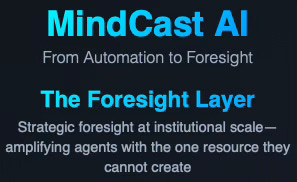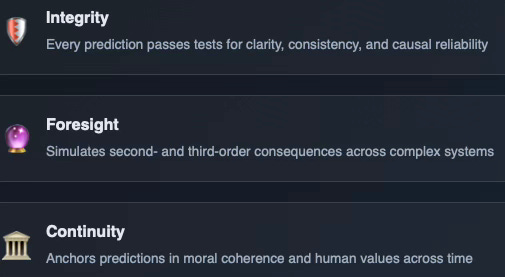MCAI Innovation Vision: Why Predictive Cognitive AI Outpaces the Agent Race
From Automation to Foresight
Executive Summary
AI today is dominated by agents—systems built to automate tasks quickly and efficiently. But agents assume the world is stable enough for their outputs to remain valid, and that assumption often fails. MindCast AI takes a different path.Built on Cognitive Digital Twins (CDTs), it models regulators, markets, courts, executives, and families as dynamic systems, showing not just what can be done, but what is likely to happen next. This shift from action to foresight is what sets Cognitive AI apart.
Unlike agents that optimize workflows, MindCast AI safeguards judgment. It validates predictions through integrity checks, anchors them in continuity and human values, and simulates outcomes across multiple futures before action is taken. The result is a foresight layer above automation—a system that amplifies the usefulness of agents while giving institutions the confidence to act strategically. Agents execute tasks. MindCast AI changes trajectories.
Contact mcai@mindcast-ai.com to partner with us on predictive cognitive AI.
I. Agents Act, Cognitive AI Thinks
Why the future belongs to foresight, not automation
AI agents are everywhere. They promise to book your travel, answer your emails, draft your contracts, and optimize workflows. Their strength lies in execution, but their weakness lies in assuming the world is stable enough for those actions to remain valid.
MindCast AI takes a different path. It was built to think, not to act. At its core are Cognitive Digital Twins (CDTs)—living models of institutions, markets, and people that simulate outcomes before decisions are made.
Agents thrive in bounded tasks like scheduling meetings or parsing data. Their benchmark for success is speed and efficiency. CDTs, by contrast, test how systems behave under pressure. They can model how a regulator will respond to new case law, how a market adapts during a shock, or how a contract could unravel years after signing.
⚡ Takeaway: Agents save time. Cognitive AI changes decisions.
II. Integrity vs. Autonomy
Why trustworthy foresight is more valuable than unchecked action
Autonomy in AI agents is often mistaken for intelligence. In reality, it can be brittle. Once an agent acts, there’s no guarantee it has weighed the right evidence or anticipated the right risks.
MindCast AI chose a different design: integrity first. Every CDT must pass three tests before its predictions are trusted:
Does its language match its intent? (What we call Action Language Integrity.)
Does it reach the same conclusion when tested under different conditions? (That’s Cognitive Motor Fidelity.)
Are its cause-and-effect predictions reliable? (That’s Causal Signal Integrity.)
These safeguards act like circuit breakers. If predictions are unclear, inconsistent, or causally weak, they are stopped before reaching decision-makers.
This matters because foresight only works if you can trust it. Without these checks, simulations drift into noise. With them, institutions gain confidence to act on what MindCast AI reveals.
⚡ Takeaway: Integrity is not a constraint on foresight—it’s what makes foresight usable.
III. Foresight as the Differentiator
The resource agents cannot create
The marketplace is crowded with firms racing to build agents. They compete on speed, integration, and coverage. But foresight—the ability to see the second- and third-order consequences of choices—is the rarest and most valuable resource of all.
MindCast AI creates foresight by simulating real-world dynamics:
Legal: An agent can draft a contract; MindCast AI can test how three different courts are likely to interpret it.
Markets: An agent can execute a trade; MindCast AI can model how regulators, competitors, and investors will respond.
Institutions: An agent can optimize schedules; MindCast AI can show how morale, turnover, and litigation risk evolve over years.
This is not a rival to agents—it is their amplifier. AI firms can plug MindCast AI into pipelines as a simulation firewall, catching risks before automation executes. Institutions can rely on it to validate or correct agent outputs, reducing liability and strengthening trust.
⚡ Takeaway: Automation delivers tasks. Foresight delivers resilience. Only Cognitive AI provides the latter.
IV. How Cognitive Digital Twins Work in Practice
Turning raw data into living foresight
Imagine a real estate regulator deciding whether to approve a merger between two large brokerages. An AI agent could gather filings, summarize market data, and draft possible arguments. But it cannot anticipate how the decision will ripple across markets, courts, and public trust.
A Cognitive Digital Twin of the regulator is different. It takes in the same filings and data, but also models how different courts might interpret antitrust law, how smaller brokerages are likely to react competitively, and how public confidence could shift if transparency rules are weakened. The CDT can then produce scenarios: “Approve the merger and risk four lawsuits in two years,” or “Block the merger but face political backlash that erodes credibility.”
This dynamic applies everywhere. A CDT of a CEO can simulate how an acquisition will play out across regulators, employees, and investors. A CDT of a family office can model how estate planning choices ripple across generations. In each case, the value is the same: turning static information into foresight that reveals what’s coming next.
⚡ Takeaway: CDTs transform information into insight. They don’t just process data—they think ahead.
V. Legacy and Trust Anchoring
Why intelligence must carry memory
Agents live only in the moment. They optimize for the immediate task without continuity of memory or responsibility. MindCast AI was built to carry history forward.
The system encodes three safeguards:
Moral Coherence: testing whether decisions remain ethical when pressure mounts.
Emotional Authenticity: ensuring predictions align with human emotional dynamics over time.
Relational Grounding: making foresight reflect human presence and social interaction, not abstract modeling alone.
These are not abstract ideals—they are structural design choices. They ensure predictions align with human values, not just technical correctness.
Because predictions are both trustworthy and anchored in continuity, they extend beyond tactical advantage. Institutions can use them to make choices that protect not only quarterly results but generational stewardship.
⚡ Takeaway: Trust comes from continuity. MindCast AI encodes both.
VI. Simulation, Not Delegation
Keeping human sovereignty in the loop
The temptation in AI is to collapse simulation into action: to build agents that act as if foresight were unnecessary. MindCast AI refuses that shortcut. It simulates agency but leaves final decisions with humans.
Simulation lets institutions test the consequences of choices before committing resources or reputation. Delegation to agents, by contrast, removes human judgment from the loop. MindCast AI restores that judgment by showing what could happen across multiple futures, while leaving action where it belongs—with people and institutions.
For AI firms, MindCast AI serves as a strategic overlay—a foresight engine that stress-tests agent proposals before execution. For institutions, it frames automation with accountability, making agents safer and more reliable.
⚡ Takeaway: MindCast AI does not replace human judgment. It protects it.
Closing Vision
MindCast AI’s refusal to build agents is not a weakness but a principle. It positions Cognitive AI as the foresight layer—one level above automation—where integrity, trust, and continuity guide decisions.
By thinking instead of merely acting, MindCast AI ensures intelligence serves judgment, institutions, and generations. For AI firms, it is the predictive firewall that strengthens agents. For institutions, it is the strategic compass that frames automation with accountability.
The competitive edge is clear: agents execute tasks; MindCast AI changes trajectories. No other AI system delivers foresight at this scale.
⚡ Final Takeaway: MindCast AI transcends the agent race. It was built not to act faster, but to think deeper—so society can choose more wisely.





